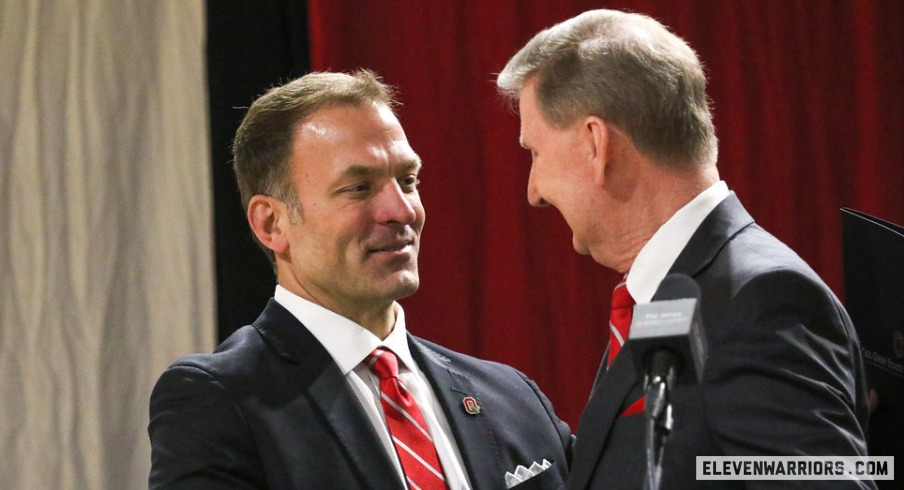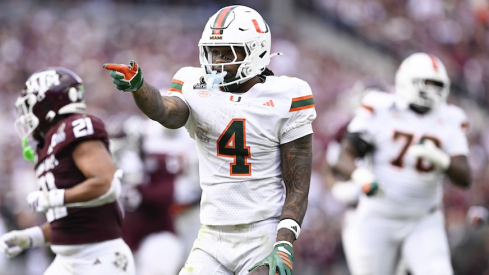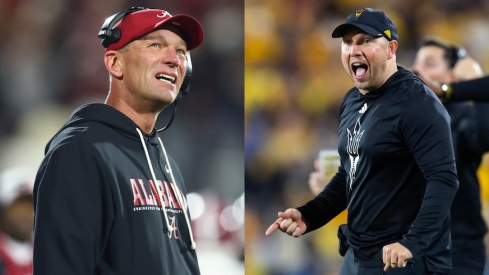The only constant in life is change, and change has remained constant in college sports through the last half-decade.
NIL, the transfer portal, these alterations to the landscape of interscholastic athletics have been well-documented. Another unfamiliar forest looms on the horizon, however – revenue sharing. Soon, along with the NIL dollars that teams are trying to get some guardrails around, athletic departments will have more to balance in terms of player pay and budgetary considerations.
With all that change comes a change in leadership at the top for Ohio State, with the Gene Smith era coming to an end and the Ross Bjork era beginning on Monday. One of the first acts of newly-minted Buckeye president Ted Carter in January was to hire Bjork, and one of the top reasons why he chose the former Texas A&M AD was his adaptability.
“Ross has a view of the changing landscape of college athletics, and we're going to need that kind of leadership,” Carter told Eleven Warriors on Real Pod Wednesdays. “I mean, as we're sitting here doing this conversation, something has probably just changed again in college athletics. And Ross is that leader that's going to help guide us through these next multiple chapters that we're going to have.”
Carter made sure to pay respect to what Smith accomplished in his 19 years as Ohio State’s athletic director. Carter met the now-Arizona resident in 2014 as superintendent of the U.S. Naval Academy when Navy played the Buckeyes in football, and before he got to know Smith better as an administrator there was a great admiration there.
“There really is no replacing Gene Smith,” Carter said. “I could not.”
As one might anticipate, Carter said there was a who’s-who of interested athletic directors when it came time to interview and hire Smith’s replacement. But Bjork’s background – though not spotless – made him the clear choice in Carter’s view.
Bjork landed his first athletic director job at Western Kentucky in 2010, then the youngest of all ADs in the FBS at 37. He was hired to lead Ole Miss’ athletics department in 2012 then Texas A&M’s in 2019.
With the Aggies Bjork made two decisions that came under scrutiny later, the extension of head football coach Jimbo Fisher to make his contract 10 years and $95 million, then the attempted hiring of head coach Mark Stoops from Kentucky. Fisher flamed out after a 5-7 season in 2022 and a 6-4 start to 2023, Stoops’ selection was vetoed by Texas A&M’s board of regents who were unimpressed with his two most recent 7-6 seasons at Kentucky.
“What made Ross stand out was his experience,” Carter said. “He was the youngest Division I athletic director in the country. He had been through multiple athletic director programs, some that had some controversy. And that's been noted. I answered that at his opening press conference. I made a comment that smooth seas never made a good sailor. And Ross had been through some rough seas, and I thought he handled things about as well as he could.”
Rough seas certainly lie ahead for athletic departments across the nation, Ohio State’s included. Revenue sharing means a leaner budget for the schools that make full use of the ability, as the Buckeyes intend to. By the same token, Carter, Bjork and Smith have all reaffirmed a commitment to keep OSU’s current offering of 36 varsity sports intact.
“As I've watched the college landscape and think about what it means to maintain these sports, it's important once you get them to do everything you can to hold on to them,” Carter said. “You don't want to lose that. It's too important to the student-athlete. So we've made a declarative statement that we're going to hold on to that.”
Doing so will mean certain non-revenue generating sports won’t get the championship-level funding they’re accustomed to, and the top revenue drivers – football, to a lesser extent men’s basketball and an even lesser extent women’s basketball at Ohio State – need to crank their profits up to the maximum.
Last fiscal year the Buckeyes’ athletic department ran at a deficit of more than $10 million per the Columbus Dispatch, though that comes with the important note that they only had six home football games. It’s the first full season since 2004 the team hasn’t had at least seven, and in 2024 Ohio State will host eight gridiron battles in the Shoe.
“That's not that bad of a deficit considering that on many years, we have eight home football games,” Carter said. “So, I have no doubt we'll be able to recover that. From the beginning of where we saw where athletics was going, we knew we were going to get into this revenue-sharing model, which we did support. And, of course, it hasn't been settled yet, but we would expect over the next few months it will get to that.”
"Smooth seas never made a good sailor. And Ross had been through some rough seas, and I thought he handled things about as well as he could."– Ted Carter on Ross Bjork
As Carter indicated, the exact parameters of how revenue sharing will operate and work with Title IX are still to be determined. The expected cut for athletes is 22% of the average Power Conference athletic department revenue.
One thing Carter is hopeful for is that the adjustments coming allow athletic departments to bring all of their player pay in-house, including NIL. That will allow for better regulation and monitoring.
“Reduce the third-party collectives, bring it inside, control it,” Carter said. “But then more importantly, for senior administration, whether it be at the conference or even at the NCAA level, it's got to be monitored, and there's got to be rules put in place. Otherwise, we'll still be in the wild, wild west.”
At the core of it all, Carter wants the educational side of college athletics to stay at the center of the decisions being made. In any case, he trusts Bjork to bring Ohio State into the future.
“I think instead of talking about what other changes (will occur), I think the more important piece is what should stay the same,” Carter said. “Does revenue share mean that college athletes are now professionals? Does it mean that they're employees of the university?
“I would argue that we need to do everything we can at the NCAA level and our members of Congress that may be writing laws to help define what student-athletes are going to be, we’ve got to maintain the student-athlete part. What has to be the attraction for somebody to come and wear a jersey for Ohio State still has to be to get a degree here.”


